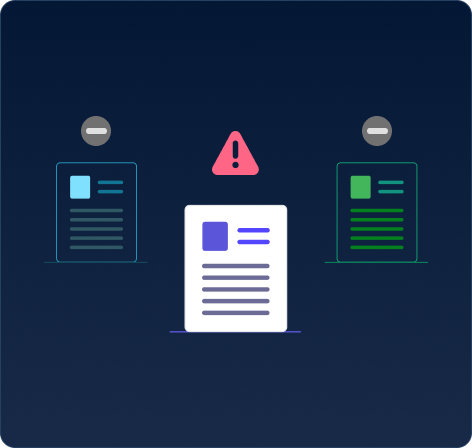Portfolio Analysis
P&C insurers need a structured way to validate whether a risk (policy applicant or renewal) fits within defined underwriting appetite. Traditional methods rely heavily on manual checks and fragmented data sources, leading to inconsistencies and errors.

CHALLENGES
Problems Our Solution Solves
- Appetite Drift
Insufficient checks can lead to writing risks outside the target appetite, increasing potential losses.
- Inefficiencies and Delays
Manual validation processes slow down quoting and binding, causing friction for customers and agents.
- Reputational & Regulatory Risks
Non-compliance with underwriting guidelines or regulatory mandates can damage the brand and lead to fines
OUR SOLUTIONS
Transforming
Challenges into Solutions
Portfolio Analysis uses AI and machine learning to assess, verify, and validate potential risks in real time. It automates the process of checking risk factors against predefined criteria, data, or external sources.
Automated Risk Validation Engine
Ingest policy application data, third-party data (e.g., credit scores, vehicle telematics, property data), and internal rules to confirm if a risk aligns with appetite.
Risk Scoring & Thresholds
Develop AI/ML models to generate a risk scores;
auto-approve or auto-reject based on appetite rules.
Dynamic Appetite Management
Continuously refine appetite rules using insights from emerging risks, claims data, and market changes.
Real-Time Alerts & Exceptions
Automatically alert underwriters when a risk is borderline or outside of appetite, prompting a deeper review.
Audit Trail
Maintain an audit log of all risk validation decisions to ensure transparency and regulatory compliance.
Geospatial Analysis
Highlight geospatial contribution of the individual risk to the book and reduce reinsurance layer cost
Outlier Detection
Identify applications with unusual characteristics or inconsistent data that may require additional scrutiny.
KPIs
Appetite Adherence Rate: Percentage of policies bound that fall within the defined risk appetite. Exception Handling Volume: Number of applications flagged for manual review. Time-to-Decision: Speed at which an underwriting decision is made. Loss Ratio by Appetite Segment: Monitors how accurately appetite rules correlate with profitability.
Workflow
Integrate risk validation checks into the underwriting process, so underwriters receive instant feedback on whether a submission meets appetite guidelines. Automate routine tasks (e.g., data gathering, initial risk scoring), allowing underwriters to focus on complex exceptions.
IMPACTS
Why It Matters
Reduced Loss Ratios
Writing risks that are better aligned with the insurer’s appetite reduces exposure to high-severity claims.
Operational Efficiency
Automated validation accelerates underwriting decisions, improving quote-to-bind turnaround times.
Compliance & Governance
Consistent application of underwriting rules minimises regulatory and reputational risks.
Enhanced Stakeholder Confidence
Clear audit trails and transparent risk validation processes in-still confidence among regulators, reinsurers, & internal stakeholders.
Reduced Reinsurance Cost
Balance CAT exposure and reduce exceedance probabilities reducing loss exposure.
FAQs
Frequently Asked Questions
What is OverseeAI?
Manual document submission and processing in P&C insurance underwriting are slow, error-prone, and lack real-time tracking. Currently available solutions lack visibility, adaptability and interpretability.Manual document submission and processing in P&C insurance underwriting are slow, error-prone, and lack real-time tracking. Currently available solutions lack visibility, adaptability and interpretability.
What type of Users can benefit from OverseeAI?
Manual document submission and processing in P&C insurance underwriting are slow, error-prone, and lack real-time tracking. Currently available solutions lack visibility, adaptability and interpretability.Manual document submission and processing in P&C insurance underwriting are slow, error-prone, and lack real-time tracking. Currently available solutions lack visibility, adaptability and interpretability.
What ROI can I expect from implementing OverseeAI?
Manual document submission and processing in P&C insurance underwriting are slow, error-prone, and lack real-time tracking. Currently available solutions lack visibility, adaptability and interpretability.Manual document submission and processing in P&C insurance underwriting are slow, error-prone, and lack real-time tracking. Currently available solutions lack visibility, adaptability and interpretability.
How secure is OverseeAI?
Manual document submission and processing in P&C insurance underwriting are slow, error-prone, and lack real-time tracking. Currently available solutions lack visibility, adaptability and interpretability.Manual document submission and processing in P&C insurance underwriting are slow, error-prone, and lack real-time tracking. Currently available solutions lack visibility, adaptability and interpretability.
How do OverseeAI integrate with existing business tools?
Manual document submission and processing in P&C insurance underwriting are slow, error-prone, and lack real-time tracking. Currently available solutions lack visibility, adaptability and interpretability.Manual document submission and processing in P&C insurance underwriting are slow, error-prone, and lack real-time tracking. Currently available solutions lack visibility, adaptability and interpretability.
